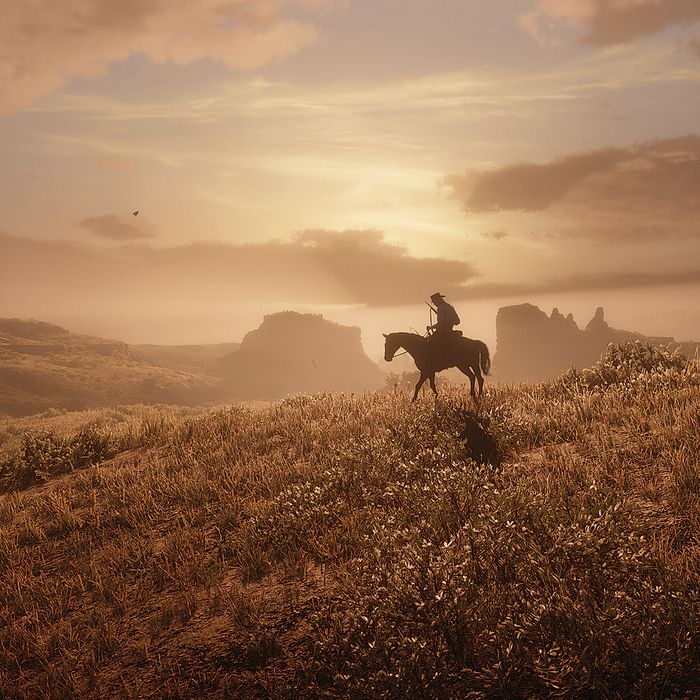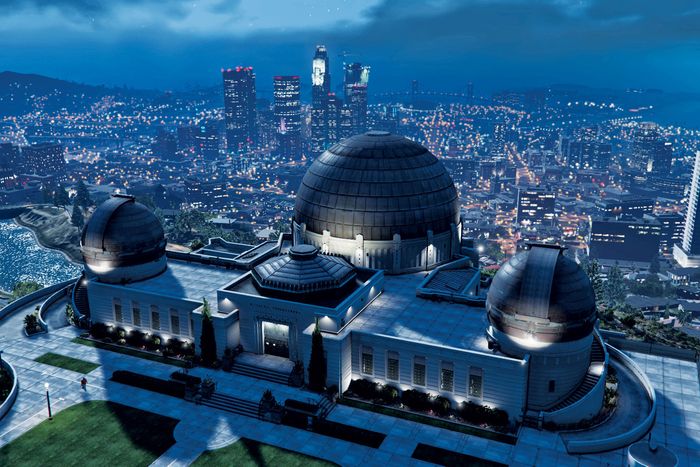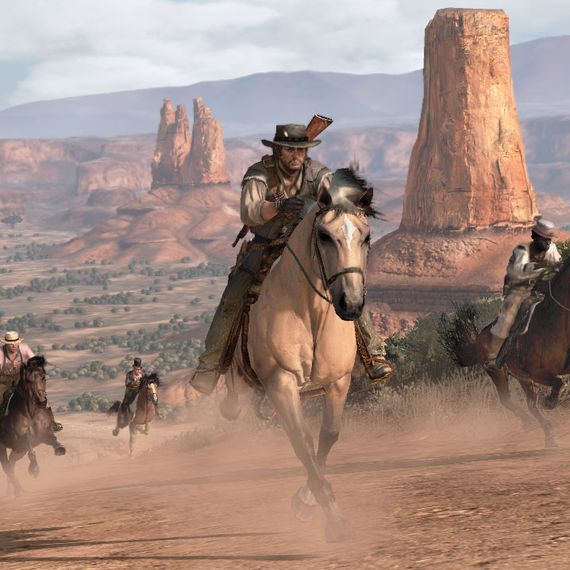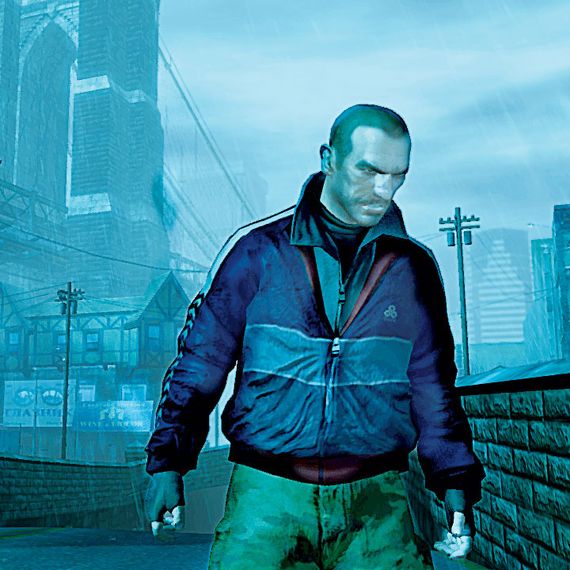
You can’t simply stroll into the Manhattan offices of Rockstar Games. If you make it past the downstairs lobby and up the elevator, a thick metal door blocks your way. After you’re buzzed inside, you’ll need to wear a laminated visitor’s pass to get beyond reception. It’s quiet, save for a mix of Living Colour’s “Cult of Personality” and the sounds of a video game cowboy riding a horse on a nearby TV. Signs warn you not to post anything about your visit on social media. Even in the bathroom, a placard jabs, “Lift the Seat Before You Leak: Offenders Will Be Sacrificed.” Outside it, a worker bee looks at me suspiciously and escorts me back to reception. “You’re not supposed to be out here without someone watching you,” he says.
Inside this highly secure enclave, one of the world’s most successful writers dwells. Along with the team he oversees, Dan Houser, 44, is in no small way responsible for a great portion of tens of billions of dollars in video-game sales, and unless you’re someone who pores over credits, you probably don’t know his name. Dan and his brother, Sam, 47, who emigrated from London to New York to found Rockstar Games in the ’90s, prefer it that way. They hardly ever give interviews, and they’ve never taken a PR photo together. With fame comes annoying obligations and, as Dan has observed by proximity to celebrities he’s worked with, “lots of girls who only want to speak to you or have sex with you because you’re famous. And in exchange for that, you give up your whole soul.” Rockstar hasn’t had a booth at E3, the nation’s biggest game convention — which Sam considers “a big sort of willy-waving exercise” — in over a decade. On the company’s website, they refer to themselves as “impressionable idiots on a mission to entertain.”
But the work sells itself. Rockstar’s last release, Grand Theft Auto V, the 2013 action game for which Dan was the lead writer, earned $1 billion in its first three days and has sold nearly 100 million copies. In April of this year, GTAV — made on a reported budget of $265 million — passed $6 billion in sales, making it the highest-grossing entertainment product in history. (Avatar, the highest-grossing movie ever, earned only a measly $2.8 billion in theaters.)
So there’s a feeling of excitement in the Rockstar offices in early June, five months before the launch of its next project: Red Dead Redemption 2, a prequel to 2010’s open-world Western game Red Dead Redemption, which sold over 15 million copies. Even though RDR2 has been in development for seven years, there’s still much to be done. I’m here today to watch an hour’s worth of game footage.
What I see convinces me that Rockstar may have once again pushed games forward as an art form. RDR2 is set in 1899, at the end of the Wild West era, and features a character named Arthur Morgan, a square-jawed, mostly moral cowboy who begins to question the motives of the outlaw gang he belongs to. The game is a mix of stunning artwork, smart writing, and crafty artificial intelligence that makes even non-playable characters on the side of the road seem sentient. Unlike with most current games, there’s no waiting for a scene to load; you move without interruption from game play to movie-like cut scenes. Its world feels fully realized, as if players could live in it and put down virtual roots. But I won’t know for sure until I play it — and they won’t let me do that yet.
Rockstar seldom fails. Its games are like interactive Scorsese or Tarantino movies, open-world crime sagas or Westerns, with casts of well-shaded antiheroes, in which players can go anywhere or do anything — including complete the prescribed missions or just explore — and then watch the environment respond, as though its designers had anticipated their every move. Arguably, because Dan Houser and Grand Theft Auto III, Rockstar’s breakthrough hit, set the bar high for crime games, Amy Hennig (the Uncharted series) and Ken Levine (Bioshock) could raise it in other genres. “The Rockstar guys are just so good at making the world feel alive,” says Neil Druckmann, an award-winning game writer himself (The Last of Us), and the vice president of Naughty Dog, the studio behind the Uncharted series, which has sold many millions of copies. “Even just the beauty of riding a horse through gorgeous environments and having the light shifting — it feels so real.”
In August, I receive an email from Sam Houser, Rockstar Games’ president, who writes, “We’ve poured everything we have into [RDR2]. We have really pushed ourselves as hard as we can.” In the past, Dan Houser, Rockstar’s vice-president for creative, has spoken emotionally about how hard he and the company’s teams — ten across the globe, from California to India — work. “That was shit,” he says. “This was the hardest.”



In mid-September, I talk with Dan Houser for six hours over two days. During one meeting, he sits on a leather couch in the Rockstar office, tall, bald, in gym clothes and white Adidas sneakers, fondly recalling his company’s tumultuous early history.
Rockstar was born out of the remnants of video-game-maker BMG Interactive — Dan and Sam’s previous employer, where Dan cut his teeth writing trivia for the You Don’t Know Jack series — which was shuttered in 1998 and eventually, owing to Sam’s persistence, had its assets acquired by the New York-based holding company Take-Two Interactive. Disappointed, Dan left home in England for a months-long solo trip through South America. In December of that year, he took a walk on a beach in Cartagena, Colombia. “I made a huge mistake. The police don’t start until 10 a.m. This was 9 a.m. and I was being chased by three hobos wielding machetes and a broken gun.” He ran for a taxi and found an internet cafe. There, he checked his email and found a note from Sam, asking him to come to New York and work for Rockstar, under the Take-Two umbrella. It was the perfect deus-ex-machina moment, “the right email at the right time,” says Dan. A week later, he was in Manhattan, working with Sam in the corner of an attic loft in SoHo.
The company’s early staff was a party-hard, work-harder crew that disagreed when it needed to, says Sam Houser (who generally stayed away from the partying himself). “If there’s an issue, we’re going to have it out. And we’re going to clear the air, and we’re going to move on from it. We’re not going, ‘Oh, there’s an issue, let’s just let it go away.’ Because it doesn’t go away, it just festers somewhere down in your stomach, and then explodes out on another day.” But those who stayed were well rewarded over the years: Jennifer Kolbe, for instance, rose from a job at the front desk of Take-Two to one of the most powerful positions in video games as Rockstar’s head of publishing.
Navid Khonsari, an award-winning director and virtual reality game maker who worked with Dan on a number of Grand Theft Auto games, gets excited remembering his time at Rockstar: “Some people think Dan is a dick. But he wasn’t to me. We always worked ourselves to the bone. But it wasn’t coming from the top down. Sam and Dan always rolled up their sleeves and they were always there. They never left us holding the bag. We all thought we were making badass shit, so it didn’t matter how hard we worked.” (Prior to motion-capture shoots, Dan and Khonsari would talk about the film directors that would influence their stories, from Scorsese to Singleton to Malick to Oliver Stone. “His knowledge of film is immense,” says Khonsari.)
Before Grand Theft Auto III, Dan remembers that Take-Two was “a hundred million dollars in debt. It was money we didn’t spend but money we had to make back. That was a real stress. We made a $300 million profit, and Take-Two has never been in serious trouble since.”
Unserious trouble, though, maybe. When a hidden graphic sex scene was discovered in 2004’s Grand Theft Auto: San Andreas — the so-called Hot Coffee mod, in which the game’s protagonist can be seen having intercourse with his girlfriend — Congress demanded an FTC investigation. Company emails were subpoenaed and Sam was questioned by the FTC. “The scale of this stress always had the air of ludicrousness to me,” says Dan. “It always felt like they were trying to find a reason to attack us. It was so drawn out. But I wasn’t directly in the line of fire. It took a greater toll on those who were than it did on me.”
In 2002, Take-Two acquired another developer, Angel Studios, and saw potential in one of its canceled games, Red Dead Revolver, about a bounty hunter seeking revenge for the murder of his parents. Angel Studios was rebranded Rockstar San Diego and the game was published in 2004. It did well enough that Rockstar soon commenced work on 2010’s Red Dead Redemption, a big-budget, big-idea-filled Western with Dan’s narrative imprint everywhere.
In early 2011, Dan began chatting with Rockstar San Diego about how Red Dead Redemption 2 would look and who the characters would be. Late that summer, he says, he had a “broad outline and rough flow of the game defined.” By fall 2012, his team had completed rough scripts for many of the game’s missions and started doing read-throughs on video conference calls with directors of game play, art design, and animation from Rockstar offices around the world. On those calls, Dan, who took some acting classes in school, sometimes performed every role. Says motion-capture director Rod Edge, “If the character is high intellect and has Dan’s energy, his acting is perfect.”
The final script for Red Dead Redemption 2’s main story was about 2,000 pages. But if he were to include all the side missions and additional dialogue, and stack the pages, Dan estimates the pile “would be eight feet high.” Bringing the script to life meant 2,200 days of motion-capture work — compared with just five for Grand Theft Auto III — requiring 1,200 actors, all SAG-AFTRA, 700 of them with dialogue. “We’re the biggest employers of actors in terms of numbers of anyone in New York, by miles,” says Dan. Before a motion-capture shoot that would last two or three weeks, there were meetings “four hours each day for four days. We want it as tight as possible for motion-capture because we’re burning a lot of money very quickly [at those sessions].”
“We always did try to dream big,” says Edge, who directed the majority of those sessions, beginning in 2013, at Rockstar’s motion capture studio in Bethpage, New York. As a kid, he says, he had always wanted to direct a Western, with Hitchcockian camera angles shot from characters’ perspectives, and John Ford’s “strong sense of framing.” But Red Dead Redemption 2 was “much harder to direct than a movie, when [the actors] are wearing skin-tight futuristic-looking [mo-cap] suits.”
The polishing, rewrites, and reedits Rockstar does are immense. “We were working 100-hour weeks” several times in 2018, Dan says. The finished game includes 300,000 animations, 500,000 lines of dialogue, and many more lines of code. Even for each RDR2 trailer and TV commercial, “we probably made 70 versions, but the editors may make several hundred. Sam and I will both make both make lots of suggestions, as will other members of the team.”
The result of all their labor, Dan says, is “this seamless, natural-feeling experience in a world that appears real, an interactive homage to the American rural experience. [It’s] a vast four-dimensional mosaic in which the fourth dimension is time, in which the world unfolds around you, dependent on what you do.”
In late August, I get an invitation to play nearly six hours of Red Dead Redemption 2 from the beginning, the first time a North American journalist will be allowed to do so. In Rockstar’s reception area, I see Lazlow Jones, a former tech journalist who has been writing for Dan since Grand Theft Auto III. He tells me that “even the peds [RDR2’s non-playable characters] have 80-page scripts — each.”
In Rockstar’s demo room, the lights go down and it’s all game. Unlike the initial brightness and optimism of the original Red Dead Redemption, set in a more civilized 1911, RDR2 begins with a bleak winter storm. In a barn lit only by a flickering lantern, someone dies. “We’ve just had a bad couple of days,” says Dutch van der Linde, the leader of the outlaws, to his charges. “Stay with me. We ain’t done yet.” That’s hard for his gang of smart but drunken and wild misfits to imagine, because the sheets of ice outside are as nasty as the ones in Ian McGuire’s The North Water. It’s in this blizzard that we get to know our hero, Morgan, a swaggering but deliberate cowboy who seems weighed down with baggage from the past and with a fear of the future. (Morgan has his softer side, too; he writes and draws in a journal.) Says Dan later, “The frontier environment and the force of civilization will destroy people like [Arthur]. He’s caught between the nastiness of nature and the brutality of encroaching industrialization in civilization. He has a feeling that his time may have come and gone.”
The gang moves to a snowy hilltop before engaging in a shoot-out near a cabin. Later, you’re asked to rescue a young, injured John Marston, the protagonist of the first game, high in the blizzard-ridden mountains, so you trudge forth through snow up to your thighs.
As winter becomes spring and you move around on your horse, you take time to check out the panoramas the way you would stop at observation points in Sequoia National Park or the Grand Canyon. The vistas are hyperreal, inspired by luminous paintings like those by Albert Bierstadt of the Hudson River school. RDR2’s art director Rob Nelson says the team wanted the game world to respond to the story, so much so that “we were obsessed with it feeling natural or organic in every respect. Everywhere you look, you see something that is drawing you toward it.”
Everything feels real: the starry, unpolluted night, the cicadas, the 360-degree buzz of a fly around your head. You hear horse hooves clip-clopping nearby. Should you fight? Should you hide? You think about a woman you passed in your gang’s camp who asked you what you thought about local superstitions. You imagine what her life must have been like before she joined the gang. Game critics always call this “being immersed,” but “immersed” almost doesn’t do it justice. This world of Red Dead Redemption 2 feels so alive and real, you feel projected into it and then possessed by it. After a few hours, you can almost feel the ego diminution, the sense of “merging with nature or the universe” that Michael Pollan describes in How to Change Your Mind. (And at $60 for a copy, Red Dead Redemption 2 is cheaper than psychedelic drugs.)
The soundtrack helps, too. You hear sounds of nature, long ambient notes in the wilderness, or the Irish-influenced strain of an antique banjo from a nearby campfire. “We have 192 interactive mission scores, and we thought about the music constantly from the time we brought in [composer] Woody Jackson in 2015,” says Ivan Pavlovich, Rockstar’s music supervisor. “Sam was always asking early on, ‘What’s the feel [of the game]?’ ” The feels are many: Pavlovich says players can hear entire concerts at town vaudeville shows, as well as more atmospheric music when they explore the open world and encounter some 200 animal species, each of which makes its own sound.
“The first [RDR] is about a man [Marston] trying to save his family from his past,” says Dan. “And the second one is about a bunch of outlaws who have been living in the Wild West as it’s getting tamed and the pressures that brings to bear upon one particular man [Arthur]. Changing times, changing friendships, changing places, changes emotionally and geographically. It’s more like Thackeray than Hemingway, at least in terms of scale,” with “an array of freaks, weirdos and needy people and exciting people” for variety.
Dan says for research he consumed “hundreds” of books and films, “but nothing contemporary. I don’t want to be accused of stealing ideas.” He mentions Dickens, Henry James, Keats, Émile Zola, and “Arthur Conan Doyle, who just has great sections about America, you know, like a brilliant thing about union disputes in Pennsylvania and a brilliant thing about Mormons in Utah. But there’s no greater character in the history of literature than [David Copperfield’s] Uriah Heep,” he says.
Despite its classical influences, Red Dead Redemption 2 isn’t meant to be just a period piece. As most movie Westerns reflect the era of their making, Dan says, he hopes the game speaks to the present “elliptically but not literally. You know, we don’t have this person meant to be like Donald Trump and this person like Barack Obama. It’s more this sensation that we found interesting in the 19th century that spoke to us, and I hope it speaks to people about today’s problems.”
Rockstar has been criticized for the lack of empowered women in its games. Dan believes that won’t be an issue in RDR2, which features, among others, “this old intellectual called Lillian Powell, who’s come back to the South from New York, who’s almost like a Dorothy Parker character. There are also ones who are weak and ones who are weak and become strong and ones who think they’re strong but are not. And that goes for men, too.” The burgeoning women’s suffrage movement also figures in the story. “It was a time when women were beginning to question [their roles], and the Wild West was an area where people could invent themselves for the first time; many of the people who were inventing themselves were women,” says Dan. “They were no longer constrained by society, because there was no society.”
Dan Houser has just walked from his Brooklyn home to the Rockstar offices with Iggy, his two-year-old German shepherd. He tells Iggy to stay and gives me a tour. The space’s size is deceptive because from the lobby you can see only the company’s cybersecurity team at their desks. A number of other teams are hidden elsewhere — 250 employees on two floors. And they’re taking over another floor, too. “We had to get the Take-Two executives to leave, as we need to expand,” says Dan.
He won’t let me into his own office — “It’s an absolute shithole,” he says — but tells me it’s messy and its burgundy walls are covered in Post-it notes outlining game story and missions. They were once so numerous they obscured his windows. Dan says he can write anywhere — in his office, at home, or on a plane — “or not write anywhere, if I can read the internet, which I think is what I spend most of my time doing. And then a small amount happens in the dark hours of the night. And you go, ‘Why did that take all day to get that amount done?’ But I try to get [the time between] turning on the computer to when I actually starting typing something productive down to less than three hours.”
We pass a cat, then another, Rockstar’s official mousers, before stopping inside the studio where many of the game’s 700 voice actors have recorded lines for Red Dead Redemption 2. Near the control panel, Dan recalls a time when he directed actors himself. He and Burt Reynolds had an argument about the direction of a scene from 2002’s Grand Theft Auto: Vice City. It ended with Reynolds yelling, “Get the limey out of here.”
“I don’t want to speak ill of the dead, poor bugger,” Dan says, “but we don’t bring in name actors anymore because of their egos and, most important of all, because we believe we get a better sense of immersion using talented actors whose voices you don’t recognize.” He also had trouble with Public Enemy’s Chuck D, one of his heroes, on 2004’s Grand Theft Auto: San Andreas and had to ask another director to step in. Nonetheless, Dan says, “I think rappers really want to do the work right. We also always had a good experience with pop stars. But we haven’t used either significantly for a long time.”
The most famous actor in RDR2 is Graham Greene, the Oneida performer who was nominated for an Oscar for Dances With Wolves. His role is a small one, but it’s close to Dan’s heart because it signifies everything that’s compelling about the game: history, politics, and a sense that this same kind of thing could happen in the world today. “He did such a brilliant job of bringing this chief character to life. The government is coming down on him hard. He’s losing his rights as an independent king, and he’s a gentle soul in that violent world. [Greene] bought this great depth to [the story].”
The acting for Red Dead Redemption 2’s story mode is now complete, but as release day approaches, five hours of the 65-hour game are dumped. At one point, protagonist Arthur Morgan had two love interests, but “we decided one of them didn’t work,” says Dan. And whole missions were removed because “they were never going to work technically or be quite slick enough, or they felt superfluous. We removed a mission on a train where you had to deal with bounty hunters, because it was fun at first, but then it wasn’t. This part of the process is always about compromise and horse trading. Everyone always loses bits of the game they love.”
On top of the everyday drama of game making, there’s been some additional turmoil. Producer Leslie Benzies, who worked with Dan and Sam steering the Grand Theft Auto series since GTA III in 2001, took a sabbatical, was let go, and in 2016, sued Rockstar for $150 million in unpaid royalties. When I ask about it, Dan pauses for a moment, squints, and says, “Well, we’ve got an open court case with him. So I don’t think it’s appropriate to talk about that. But I will say the team has never worked better together than it’s worked on this game.”
It’s after 8 and Houser is leaving the office with Iggy. He knows there’s plenty more work to be done. He says Rockstar might do another Red Dead game, “if this one does well enough and we think we have other interesting things to say.” But for now, his focus is on this game’s multiplayer mode, which will debut in November, for which scenes are still being written even as they are being shot in Rockstar’s mo-cap studios. Dan says “We want it to be as robust as Grand Theft Auto Online, once it’s found its feet creatively.”
Rockstar’s goal is to “slip as much art under the hood without players noticing it — but they don’t have to notice it,” says Dan. If you want, you can bypass much of the story with just a tap of the controller. “It can just be mud, blood, and gore.”
*A version of this article appears in the October 15, 2018, issue of New York Magazine. Subscribe Now!

